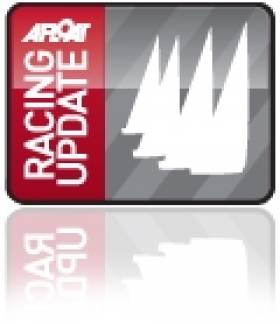Displaying items by tag: Cri Cri
#rtir – Anyone who did this year's Lambay Race will have no problem picturing what the Round the Island race was like. Lots of white sailing in uber light breeze, loads of tide and loads of sunshine writes Ric Morris who sailed on Royal Irish Quarter Tonner Cri Cri, a three time entrant into Britain's biggest yacht race.
A solid days boat prep on Friday meant we could we could afford a late start and we rolled out of the Yacht Haven with 15 minutes to go to our 0730 start. The lead boats at the Squadron end were over in the tide so we ended up starting in traffic. It took a good 5-10 minutes to find a clear lane solidly in the middle of the back eddy at Gurnard.
The first part of beat down to the Neadles we managed OK by keeping to the left had side of the caravan parade hogging the mid channel, holding our own with the lead quarter tonnes. As we approached Newtown Bay it looked like the wind ahead switched to the main land and we tacked over. Some poor traffic management -- including a somewhat curt discussion with one rather large moving wind shadow -- cost us crossing sides. The boats already out in the channel, including Illes, slipped past and Runnaway Bus, who stayed left, got away. To compound things by the time we extracted our selves mid channel the sea breeze began to swing left, lifting everyone inside us. We managed 1 tack in mid channel before eating humble pie back to the tidal shoot off Yarmouth.
The approach to the needles went well and we popped out from in between the light house and wreck less that 20 yards behind Illes and back in the hunt with the QT pack. Another 20 yards behind 2 boats tried to follow us through 'going a little wider'. Both hit the boiler with a resounding bang.
After the Needles we dug into Sctrachells Bay with Illes and initially took some distance on the other quarters outside us in a little more breeze and a lot more tide.
When Illes bailed out for breeze we decided to keep going inshore. At the end of the bay we tacked between the cliff and the Perch, dodging one submerged outcrop after a warning from another boat. The Sigma 38 behind us wasn't so lucky.
At this point the plan was to head out to sea but a 40ft catamaran blocked our path. Plan B involved some roll tacking to with in touching distance of the cliffs to picking up a sliver of breeze compressed along the cliff face. Unfortunately after it work well the first time a couple of Elan 333s and a Mini Transat decided it looked like a good idea and spoiled it for everyone. When they all hit bottom 5 yards off (you'd think people would have got the idea by now) they shut off the breeze and, with no pressure on our new fancy double sided mainsail, we had a major "puffer fish" wardrobe malfunction.
It felt like another 30 minutes to get back underway and to tack out to sea to meet the building sea breeze. On the plus side that gave us chance for a great old chat with the crew of a beautiful canoe sterned gaff rigger, comparing their 19th century technology to our mixture of 20th and 21st, as we ghosted along side each other for half a mile. By that time the rest of the QT fleet was long gone and the lead Folk Boat had more of less caught us up.
With less than an hour left in the tide we worked our way further offshore and after another 40 minutes plugging the last of the ebb we finally started to make way. For the next couple of hours chugging towards St Cathrine's in breeze and tide we passed out hundreds of boats inshore. By the time we got to the point, with the back eddy at Atherfield long over for those inside us, we where back up with the QTs and, holding our gauge 500m offshore, we passed out all but the lead 3 by the time we got to Ventnor.
Unfortunately off Ventnor the last of the sea breeze petered out and everything shut down again. The lead 3 boats and 2 inshore of us gybed off deep into Sandown Bay. Thinking that was the last of it and they would get stuck we hesitated just long enough. The gradient filled back in leaving us with no other choice than to run down the rhumb line. All 5 got a jump of 15 minutes on us at that point and after Bembridge we didn't see them again.
After rounding Bembridge ourselves the tight reach to Ryde didn't present to many issues but at the sands the spinnaker got caught around one of the battens on the main when we dropped it and we had to go head to wind for a couple of minutes to sort it out. As we headed back onto the beat home after Ryde Illes popper up and dogged us home finishing 2:29 behind, enough to beet us by 27 seconds in a little over 11 hours of racing.
It turned out to be a race for boats around 0.900 and all the quarter tonners did well. We ended up 8th quarter tonner, 5th in our 50 boat division and 17th overall. Land legs, sun stroke and celebratory Dark & Stormy's make a great combination.
Paul and the rest of the Cri Cri crew are staying out for the Quarter Ton Cup with Ben Duncan taking over the tactics. Racing starts tomorrow.























